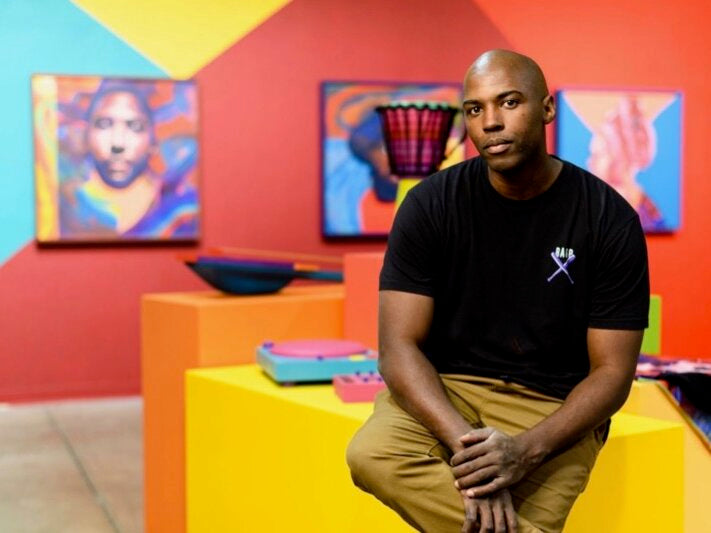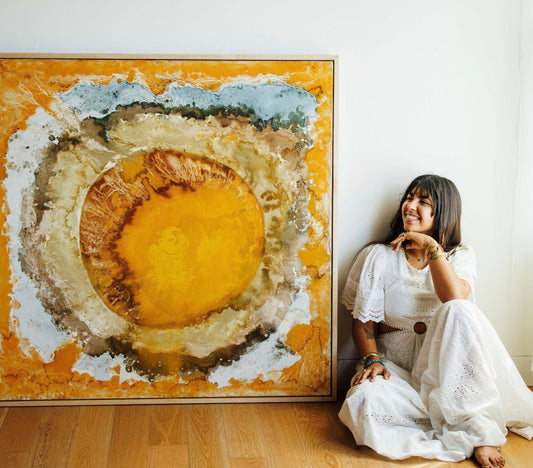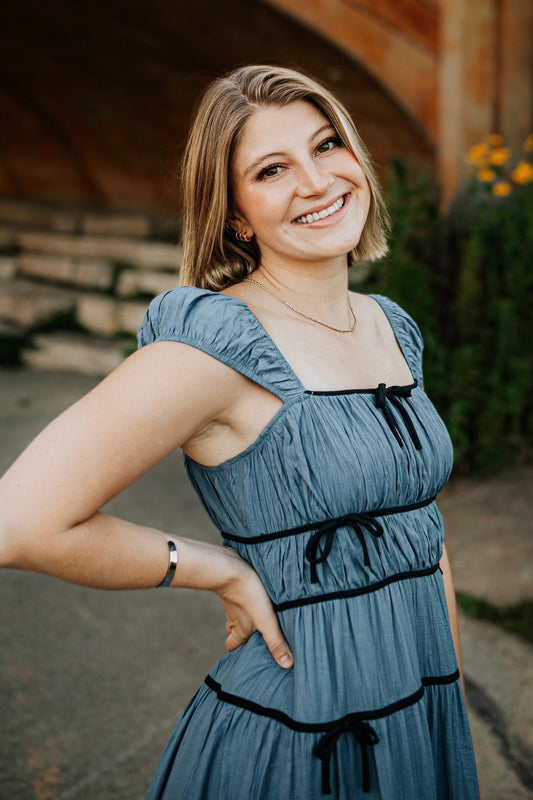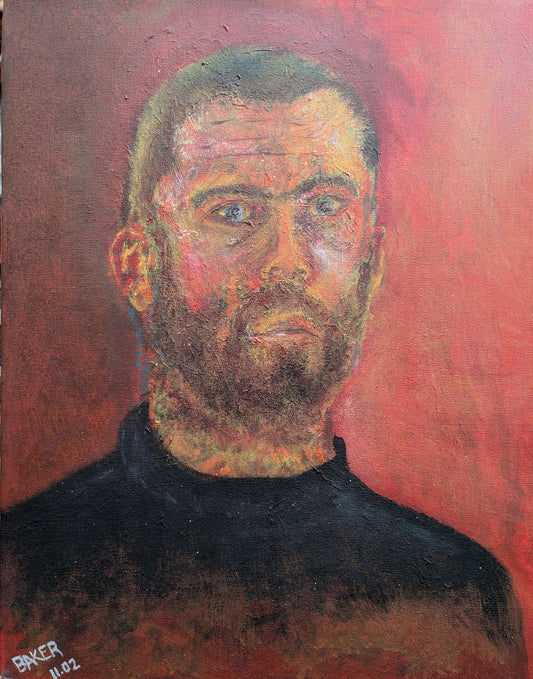Thomas “Detour” Evans is a Denver-based multidisciplinary creative growing his personal brand and teaching others as he goes. Detour works in a wide range of artistic mediums and methods, including but certainly not limited to spray paint, mural art, printmaking, music and more. In addition to his art making, Detour continues to grow his brand and ample Instagram following through his “Art Tip Tuesday” Instagram segments and recent book project titled Be The Artist.
I got the chance to ask Detour a few questions. Here is what he had to say.

Q: I know you created your first mural in Oreeswa (Arusha, Tanzania,) working with the Indigenous Education Foundation of Tanzania (IEFT) in 2014-2015 … Can you tell me a bit more about this experience? How has mural creation expanded/changed for you since that very first time?
A: I was working for this organization called IEFT. One of the jobs I had was marketing, and we had to work on making activities for sponsors when they visit. Because I was into artwork and wanted to do murals I decided “Hey, why don’t I put this paint by numbers mural up!?” During my visit, myself and the kids would be able to paint this mural. It was fun! It was really exciting for me to scale-up the mural so I used the grid system. Then, I learned about the oil paints because I could not find spray paint or any acrylic paints. It was paint that they used to do signs in Tanzania, basically paint street signs and signs of local stores or gas stations. It was all oil paints (I had never used that before) and we had to thin the paint with gasoline.
It was a fun experience and when I came back to the states, to Denver, I decided to be a full-time artist. That first mural experience really helped me out when it came to learning how to scale-up the work and everything that is involved when you are trying to scale-up your design to a larger surface.

Q: I began following your work during the Black Lives Matter protests of Summer 2020 when you and Hiero completed the George Floyd mural on Colfax Avenue in Denver, Colorado. I know that specific murals, including that one, experienced vandalism right around the same time street art and murals became such a crucial part of the BLM protests. Where do you/did you position yourself in that situation and in your opinion, what did street art do for that extremely intense politically divisive moment in our history? What should communities do for/about street art now that they are not doing?
A: My position was using street art as a way to make change and express myself. For me, the best way to make an impact is through the artwork because that is what I am good at and how I can impact people in a way that is different from everyone else. That’s why I was working with Hiero, one of my friends, to create a few murals including the George Floyd one that was vandalized… Whenever you do public art you are at risk of having your artwork vandalized so that was not a big deal. I always expect that, especially on Colfax, which is a very busy street.
Street art is used in the community to express what the community is about, the history of the community, the current situation and what you want to see in the community in the future. So street art has a very important and impactful role when it comes to impacting people in those communities.

Q: What are your thoughts on the Black Lives Matter exhibitions popping up across the country in galleries and exhibitions now?
A: A lot of these artworks have been on the plywood. A lot of artists were painting during the rallies and protests, so it is something I think a lot of artists were excited about because there were a lot of artists getting into that space of street art and painting for their first time. Having those artists be able to exhibit these works in a museum or gallery is really cool.
Q: As an artist with an MBA and a heightened focus in the business side of art in your career, what is your take on the *business*/commodification of street art and murals?
A: This is something that is definitely happening nowadays when there is so much money being pumped in the street art culture and mural culture. There are a lot of artists that would have never done art in the street or murals if there was not this monetary incentive. You see a lot of people getting into the space because it is sort of a trendy and lucrative thing to get into. So that is something to be expected whenever you have an activity, culture or art form that is infused with money, branding, fame and opportunity. It is similar to the movies, acting or the movie industry. It is something that is to be expected. Even though there is a lot of money flowing into it, there are a lot of authentic artists who are creating. There’s good and there’s bad that comes with it–it is all about trying to figure out how to navigate it.

Q: In one interview with Artistic Allies you said, “I want to be the artist I wanted to meet when I first started out” Can you describe this artist/do you feel like you have become a version of them? How has your vision of this artist shifted over the years?
A: That is another way of saying treat others how you would want to be treated. That’s pretty much what I live by when it comes to navigating my career. It really has not shifted at all because I am big on education and trying to uplift other artists and create opportunities for other artists because that is something I would want other artists to do for me.
Q: I have read and reread Be The Artist over the years when different sections feel more applicable to the moment I am in in my current artistic endeavors.. For me, it has been so important when I need affirmation and that extra push to pursue my artistic career. What do you still consider some of the best advice (from your book) for an up-and-coming artist and what would you change now—especially in a post-pandemic world and the rise of visual platforms?
A: I’m glad you read and reread the book. Something I consider really great advice from the book is to create your own opportunities. I have a section in the book that talks about that and being able to adapt with the times. Since I put out the book, a lot of things have changed… NFTs, Crypto, TikTok. Now, it's AI and artificial intelligence. There’s so many things changing, but when you are able to create opportunities for yourself and adapt your practice and how to navigate the new world because it is very different from how it was 5 years ago when I was just trying to get started. That is something I think a lot of artists can take advantage of when it comes to the advice and how to shape their practice and how they go about being the artist they want to be.
I would say there is a lot I would want to change in the book so hopefully I will have an opportunity to do a second version. Like I said earlier, there’s NFTs, there’s a lot of digital work happening, there AI, and a lot more artists are getting into murals. There are new spaces opening up for creatives and collaborations so those are some of the things I wish I had put in the book, but I don’t know that until these events happen over the past couple of years, especially due to covid. Also, how to navigate when things are taken from you due to things like covid—how to find grants, how important networking is when it comes to situations where your entire livelihood is stopped due to a pandemic. Those are some things I want to add to hopefully a second version of that book.


Q: Now moving into your more current body of sound art and sound murals: Do you feel like labeling yourself more broadly as a “full time creative” allows you to be more explorative with your mediums? If so, in which ways?
A: Labeling myself as a full time creative definitely helps to expand my ideas beyond just brushwork or murals. A lot of the artists that I follow and I am inspired by doing the same thing. When I first followed a lot of these artists, they were one-dimensional, they had one medium or one look but now, they are expanding to many different elements and you never know exactly where they are going to go, which makes it exciting. They bring something new to the table all the time and they never bore me with their new work. That is what I want to do: create something new, create something different that has not been done before. To do that, you have to be able to expand your tool set and the mediums you use or the subject matter you approach and the questions you ask in the studio.
Q: Can you tell me a bit more about your body of sound art? What inspired this body of work and do you feel like your label as a “full-time creative” helped to make this art form possible?
A: The sound art series started around 2008. I was a part of a group show and I did not want to be doing the same thing as everyone else. So, I added a pair of speakers and learned how to wire everything up to one of the early iPhones. That was super exciting and from there, I started learning more about audio engineering, sound, circuit boards and once I got into murals, I started translating a lot of work on the canvases that were sound based. For me, it was a very fun time being able to evolve as an artist and being a full time creative and calling myself a full time creative really helped out because I was not afraid to cross those boundaries when it comes to traditional art. I’m telling people to actually touch that painting as opposed to not touching it at all. Calling myself a full time creative helps me to not feel like I am stuck in a box.

Q: What do you listen to while you create?
A: When I do murals, I actually do not listen to a lot of music. I do a lot of podcasts like How I Built This on NPR or Hard Core History. A lot of them are educational because I am able to zone out and create while I am listening to podcasts. I like the long form podcasts because I am able to zone out for hours at a time and just create artworks.
Q: Who are some artists I may not know about, but should?
A: There’s quite a few artists I really like. Obata Taku makes sculptures out of these large pieces of wood and he is also a breakdancer which is something I used to do a long time ago, so, I really have a connection with a lot of his work because it talks about some of the same stuff I went through being in the dance world. Another group out of Spain is PichiAvo. They do greek statuesque sculptures mixed with graffiti and it is a really cool concept. They have recently expanded their visual language when it comes to the type of work they do and are working in a ton of different mediums. Some other artists I really like are Justin Bua, and David Garibaldi. So there’s a lot of artists I follow and get inspired by, but those are just a few.
It is extremely inspiring to see all that led Detour to become a full time creative, and I feel lucky to be able to share some of that here, at ArtRKL. I hope this conversation provokes some internal thought and external passion toward the arts, whatever that may look like for you. You can follow Detour’s full time creative journey on Instagram through his weekly Art Tip Tuesday series and learn more about his upcoming work on his website.
©ArtRKL™️ LLC 2021-2023. All rights reserved. This material may not be published, broadcast, rewritten or redistributed. ArtRKL™️ and its underscore design indicate trademarks of ArtRKL™️ LLC and its subsidiaries.





